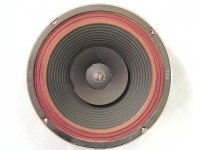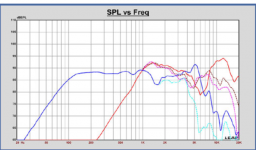I just got a pair of Thiel CS2.4 speakers and have been listening to them a few weeks now. The CS2.4 uses concentric tweeter and midrange driver and the soundstage is very special. My speakers use separate tweeter and midrange driver so the soundstage is a bit more sensitive to listening position.
The problem is the concentric design is a compromise in term of motor design, where as with separate tweeter and midrange, you can optimize so you kind of have to make your own call. There are things I prefer in my own design but the Thiel soundstage is special and something my own design cannot overcome.
This brings to a another question. I do not see a lot of quality concentric drivers offer commercially, and those that are available, their quality do leave a lot to be desired especially if you want to use first order filter.
The problem is the concentric design is a compromise in term of motor design, where as with separate tweeter and midrange, you can optimize so you kind of have to make your own call. There are things I prefer in my own design but the Thiel soundstage is special and something my own design cannot overcome.
This brings to a another question. I do not see a lot of quality concentric drivers offer commercially, and those that are available, their quality do leave a lot to be desired especially if you want to use first order filter.
I know you Americans like to put a question-mark at the end of every sentence you speak? But here, I don't see any  You might want to elaborate on what your questions actually are
You might want to elaborate on what your questions actually are 
There probably are actually some good reasons why a concentric design is better for a 1st order filter: you can cross the tweeter a bit higher because the units are so close, so destroying the tweeter is less of an issue. Then again, most drivers found are metal types and have high breakup nodes that you'll probably want to avoid. SB has some paper(-ish) coaxes I think.
There probably are actually some good reasons why a concentric design is better for a 1st order filter: you can cross the tweeter a bit higher because the units are so close, so destroying the tweeter is less of an issue. Then again, most drivers found are metal types and have high breakup nodes that you'll probably want to avoid. SB has some paper(-ish) coaxes I think.
Last edited:
I just got a pair of Thiel CS2.4 speakers and have been listening to them a few weeks now. The CS2.4 uses concentric tweeter
The Thiel 2.4 uses a wideband driver, not a concentric.
The Thiel 2.4 uses a wideband driver, not a concentric.
Sort of both. It's a single voice coil driving both mid and high, and there is some sort of system to decouple the midrange for high frequencies. It does not need any filtering. So it does act more than a wideband driver than a coax.
But that is exactly how a whizzer cone works! The mid range cone decouples from the tweeter (whizzer) diaphragm at high frequencies.The only way it could work is if midrange cone isn't rigidly coupled to the voice coil and tweeter dome is. It is quite esoteric and can't be called a midrange with the whizzer cone because it isn't.
With classic whizzer cone FR, whizzer and midrange cone are rigidly coupled together with a glue (fostex models for example - i've dismantled few of those, eminence beta12lta also, lowther). With CS2.4 midrange cone is decoupled with polypropylene suspension (a decoupling ring) from voice coil. At frequencies higher than 2,5KHz the polypropylene suspension ring starts to absorb the energy. I'm not aware of any other whizzer cone FR doing that.
With ordinary whizzer cone FR there is no decoupling of that sort, but strange directivity pattern and peak where breakup of mid-cone is, on which the response of the whizzer cone is added. Quite chaotic actually and it measures chaotic as well.
With ordinary whizzer cone FR there is no decoupling of that sort, but strange directivity pattern and peak where breakup of mid-cone is, on which the response of the whizzer cone is added. Quite chaotic actually and it measures chaotic as well.
Last edited:
Thiel also has different concentric tweeter midrange driver such as the one found in the CS2.7. I believe it's a more conventional driver since it requires an electronic xover.
But regardless, I wish there are more quality concentric drivers offered commercially off the shelf.
But regardless, I wish there are more quality concentric drivers offered commercially off the shelf.
But regardless, I wish there are more quality concentric drivers offered commercially off the shelf.
Quality in what way? What exactly do you constitute as quality?
Is it older than the "squeaker" ?In old terminology, the midrange speaker has a 'whizzer cone'.
The primary cones in 'classic' whizzer designs have different flexure characteristics to those without whizzers. Often corrugations act as compliances to subdue the high frequency vibrations of the main cone.
So, although the two cones may be glued together, the primary cone still decouples from the whizzer cone at high frequencies.
Granted, the CS2.4 employs a more sophisticated and effective method of decoupling.
So, although the two cones may be glued together, the primary cone still decouples from the whizzer cone at high frequencies.
Granted, the CS2.4 employs a more sophisticated and effective method of decoupling.
Attachments
So a coaxial a la Tannoy or, now, Kef, would not be effective with the membrane fine geometry.Often corrugations act as compliances to subdue the high frequency vibrations of the main cone.
I see
A speaker like that EV instead, has to offset the breaking force of that whizzer cone, or differentiate somehow by its kind of emission- fast, but not too much 'cos the bigger membrane holds it back, as they're glued.
Quality in what way? What exactly do you constitute as quality?
I mean in term of frequency response. For example, whizzer cones treble response is probably not ideal. If Thiel with their small operation could produce these drivers, I am not sure why ScanSpeak or Seas could not have done something similar.
But ultimately I think concentric domes are compromised because the motor design has to accommodate both the midrange and tweeter. Not only that, when the midrange driver vibrates, it modulates the tweeter so it's another thing you have to be concerned with. With separate tweeter and midrange drivers, you can optimize your motor design and material as well. Well, it's always a trade off.
Having heard the CS2.4, I am more than convinced that it offers an obvious advantage in term of soundstage reproduction. I think Kef is another manufacturers that make concentric drivers but I don't think their design is time-phase coherent.
Is it older than the "squeaker" ?
I'm not familiar with the word 'squeaker' being applied to loudspeakers.
However, the word 'squawker' is used for a mid-range driver.
It' the sound, it's obvious"! C' mon !
I'm not familiar with the word 'squeaker' being applied to loudspeakers.
However, the word 'squawker' is used for a mid-range driver.
Attached is the frequency response of Morel Hybrid Integra 524, 5" Coaxial Driver. The tweeter has large dip and the frequency response is just too ragged. I use this driver as an example but most coaxial drivers don't have very smooth frequency response. Not only that, you pretty much have to use higher order filter.
Attachments
- Status
- This old topic is closed. If you want to reopen this topic, contact a moderator using the "Report Post" button.
- Home
- Loudspeakers
- Multi-Way
- Tweeter midrange concentric vs. separate drivers

